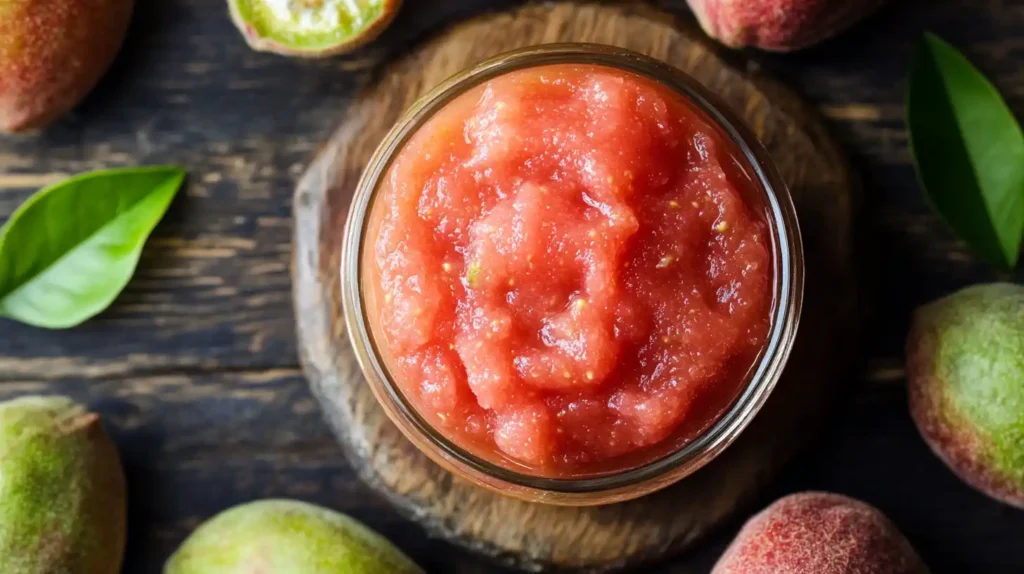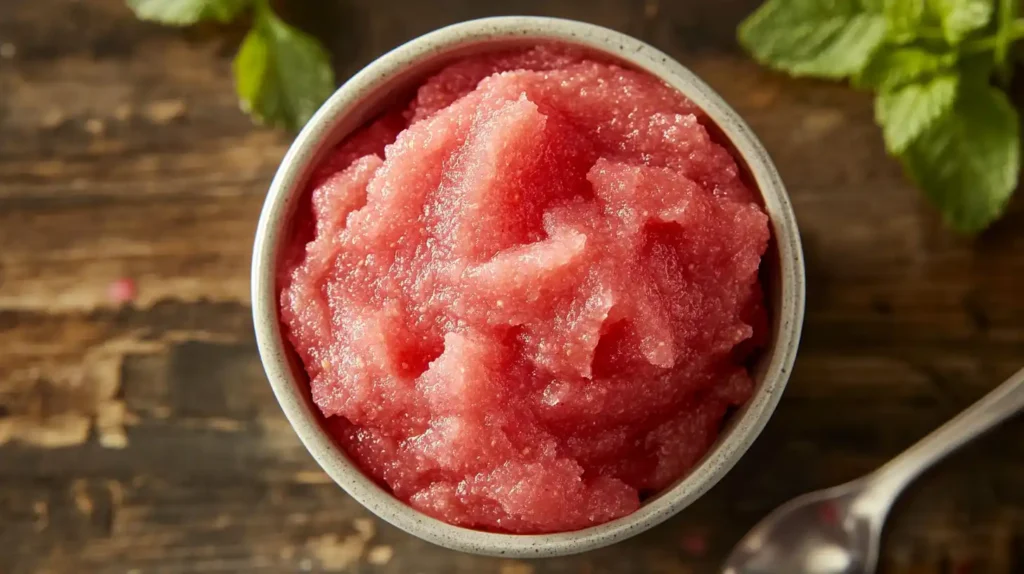Table of Contents
Introduction to Guava Paste Recipe
Guava Paste Recipe is a beloved culinary treasure, valued for its smooth texture, vibrant flavor, and versatility in both sweet and savory dishes. This tropical delight has a rich history and cultural significance that spans continents and cuisines. Let’s explore what makes guava paste so special.
What Is Guava Paste Recipe?
Also known as “goiabada” in Portuguese-speaking countries, is a dense fruit preserve made by cooking guava pulp with sugar until it thickens into a luscious, spreadable or sliceable consistency. Its taste is a harmonious blend of natural guava sweetness and subtle tanginess.
Key characteristics:
- Texture: Smooth and firm, yet pliable enough to be spread or cut into slices.
- Color: Often a deep pink or reddish hue, depending on the type of guava used.
- Uses: Versatile in the kitchen, it can be served with cheese, baked into desserts, melted into syrups, or even used as a glaze for meats.
Its ability to balance sweetness and tang makes it a sought-after ingredient across cultures, offering endless possibilities for culinary creativity.
History and Cultural Significance of Guava Paste Recipe
The origins of guava paste are deeply rooted in the tropical regions where guava fruit grows abundantly. Over time, it has become a staple in many cuisines, especially in Latin America, the Caribbean, and parts of Asia. Here’s a glimpse into its historical journey:
- Latin America: In Brazil, it is famously paired with cheese in a dish known as “Romeo and Juliet” (“Romeu e Julieta”), symbolizing the perfect marriage of flavors. Its popularity spread throughout Latin America, where it is often used in desserts and snacks.
- The Caribbean: Guava paste is an essential ingredient in Caribbean kitchens, featured in pastries, sauces, and festive treats. It reflects the tropical bounty of the islands and has become a cultural staple.
- Asia: In regions like the Philippines, guava preserves, including guava paste, are a popular way to enjoy the fruit year-round.
- European Influence: Colonization played a role in introducing guava paste to European palates, particularly in Spain and Portugal. It became a favored export and has remained a cherished delicacy.
The cultural significance of this recipe lies not only in its taste but also in its ability to bring people together. From festive celebrations to casual snacking, it transcends borders and generations, uniting people through its tropical allure.
Why Make Guava Paste Recipe at Home?
While store-bought options are convenient, making it at home allows for customization and ensures no artificial additives or excess sugar. Here’s why you should give it a try:
- Freshness: Homemade guava paste boasts a richer and more authentic flavor than commercial varieties.
- Customization: Adjust sweetness and experiment with spices like cinnamon or nutmeg to suit your taste.
- Economical: Utilize fresh, seasonal guavas for a cost-effective batch.
Health Benefits of Guava Paste Recipe

It is not only a delicious tropical treat but also offers several health benefits when consumed in moderation. While it’s sweetened and processed into a paste, it still retains many of the nutritional advantages of the guava fruit. Here’s a closer look at its nutritional profile and the key benefits it provides.
Nutritional Profile of Guava
Guava, the primary ingredient in guava paste, is a nutrient-rich fruit known for its impressive health benefits. Even in its processed form as a paste, it retains some of these valuable nutrients. Here’s what makes guava a powerhouse:
- Rich in Vitamin C: Guavas contain a high concentration of vitamin C, which supports immune health and acts as a powerful antioxidant.
- Fiber Content: Guavas are a good source of dietary fiber, aiding digestion and promoting gut health.
- Low in Calories: Despite being naturally sweet, guavas are low in calories, making them a healthy fruit choice.
- Packed with Antioxidants: Compounds like lycopene and flavonoids help fight oxidative stress and may reduce the risk of chronic diseases.
- Minerals: Guavas are rich in potassium and magnesium, which support heart health and muscle function.
Pro Tip: While guava paste contains added sugar, it still retains antioxidants and some fiber, offering a balance of indulgence and nutrition.
Key Benefits of Guava Paste Recipe
Though it is sweetened and less raw than fresh guava, it offers several benefits, especially when included as part of a balanced diet:
- Energy Boost
- The natural sugars and carbohydrates in guava paste provide a quick source of energy, making it an excellent addition to breakfasts or pre-workout snacks.
- Digestive Health
- Guava paste contains a portion of the fiber from guavas, which can aid digestion and support bowel regularity.
- Antioxidant Properties
- Thanks to its guava base, guava paste delivers antioxidants like lycopene, which combat free radicals and may support skin health and cellular repair.
- Supports Immune Health
- The vitamin C in guava paste, though reduced during processing, still contributes to immune function and overall wellness.
- Stress Relief
- Guava contains magnesium, which promotes relaxation and helps manage stress. A moderate serving of guava paste can be a comforting treat for stressful days.
- Heart Health
- Potassium from guavas can contribute to maintaining healthy blood pressure levels, and guava paste retains some of this essential mineral.
Pro Tip: Enjoy it with protein-rich foods like cheese to create a balanced snack that slows sugar absorption and enhances satiety.
Essential Ingredients for Guava Paste Recipe
Creating the perfect guava paste begins with selecting the right ingredients. Each component plays a critical role in achieving the desired flavor, texture, and quality. Here’s a closer look at the essentials:

Choosing the Best Guavas
The foundation of a great guava paste is high-quality guavas. Their flavor and ripeness will directly influence the paste’s taste and consistency. Follow these tips to select the best:
- Ripeness: Choose guavas that are ripe but not overly soft. Ripe guavas have a sweet aroma and yield slightly when pressed.
- Type of Guava: While any guava can be used, pink guavas are preferred for their vibrant color and sweetness. White guavas yield a subtler flavor and a lighter hue.
- Freshness: Avoid guavas with blemishes, bruises, or signs of mold. Fresh, unblemished fruits ensure a clean, pure flavor.
Pro Tip: If guavas are not in season, frozen guavas can be a convenient alternative. However, fresh guavas yield the best results.
Sweeteners and Their Alternatives
Sweeteners are a crucial ingredient in guava paste, enhancing the natural flavor of the fruit while preserving the paste. Here are some options:
Traditional Sweeteners
- Granulated Sugar: The most common choice, providing a neutral sweetness and acting as a natural preservative.
- Brown Sugar: Adds a subtle caramel-like flavor and a deeper color to the paste.
Healthier Alternatives
- Honey: A natural sweetener that imparts a mild floral flavor, perfect for those seeking a healthier option.
- Stevia or Monk Fruit Sweetener: Ideal for a sugar-free version of guava paste. Adjust the quantity to avoid overpowering the natural guava flavor.
- Agave Syrup: A vegan alternative that blends well with guava’s tropical profile.
Pro Tip: If using liquid sweeteners like honey or agave, reduce the water content slightly during cooking to prevent a runny paste.
Optional Spices for Flavor Variations
Adding spices to your guava paste can elevate its flavor profile, making it more complex and unique. Here are some popular options:
- Cinnamon: A classic choice that complements guava’s sweetness with warm, earthy notes.
- Nutmeg: Adds a hint of spiciness and a rich aroma, ideal for holiday-inspired variations.
- Vanilla Extract: A splash of vanilla can bring a creamy, dessert-like quality to the paste.
- Cloves: Use sparingly for a bold, spicy kick.
- Star Anise: Imparts a licorice-like flavor, perfect for adventurous palates.
Pro Tip: Start with a small amount of spice, taste as you go, and adjust to your preference. Overpowering the natural guava flavor can detract from the paste’s authenticity.
Final Thoughts
Selecting high-quality guavas, choosing the right sweetener, and experimenting with spices are the key steps to making a guava paste tailored to your taste. Whether you stick to the traditional recipe or try creative variations, these ingredients will help you craft a delicious and versatile paste to enjoy in countless ways.
Selecting the Right Guavas
The quality of your guavas significantly impacts the final product. Follow these tips to pick the best:
- Look for ripe guavas that are firm but slightly soft to the touch.
- Avoid overly hard or blemished fruits as they may lack flavor or sweetness.
- Choose aromatic guavas, as their fragrance indicates ripeness.
Tools You’ll Need
Ensure you have the following tools ready to streamline the process:
- Medium-sized pot: For boiling and reducing the guava pulp.
- Blender or food processor: To create a smooth puree.
- Strainer or sieve: For removing seeds and achieving a silky texture.
- Wooden spoon: Ideal for stirring the paste as it thickens.
- Sterilized jars: Essential for safe and long-lasting storage.
Properly sterilizing jars is critical for preserving your paste. For tips, check out this Digital Recipe Book Guide on storage and preservation.
Preparing the Guavas
- Wash Thoroughly: Rinse the guavas under cold running water to remove dirt and residue.
- Peel (Optional): Peeling the guavas can result in a smoother paste but is not mandatory.
- Core the Fruit: Slice the guavas in half and remove the seeds using a spoon. This step is crucial for achieving the silky consistency characteristic of guava paste.
- Chop into Pieces: Cut the guava flesh into small chunks to facilitate even cooking.
Step-by-Step Guide to Making Guava Paste Recipe
1: Boil the Guavas
- Place the chopped guavas into a medium-sized pot and add enough water to cover them completely.
- Bring the pot to a boil over medium heat, then reduce to a simmer. Allow the guavas to cook for about 15–20 minutes or until they soften.
- Stir occasionally to prevent sticking.
2: Blend the Cooked Guavas
- Once the guavas are soft, remove them from the heat and allow them to cool slightly.
- Transfer the guavas to a blender or food processor. Blend until the mixture reaches a smooth, consistent puree.
3: Strain the Puree
- Using a fine mesh strainer or sieve, pass the guava puree through to remove any remaining seeds or coarse bits. This step ensures your paste will have a creamy texture.
- Collect the strained puree in a clean bowl.
4: Cook the Paste
- Return the strained puree to the pot. Add sugar to taste, typically about 1 cup of sugar for every 2 cups of guava puree.
- Stir in a tablespoon of lemon juice for every 2 cups of puree. This not only balances the sweetness but also helps preserve the paste.
- Cook the mixture over medium heat, stirring frequently with a wooden spoon to prevent burning.
5: Reduce to Desired Consistency
- As the mixture cooks, it will gradually thicken. Continue to stir until the paste reaches your preferred consistency. This process can take 30–45 minutes.
- You’ll know it’s ready when the paste pulls away from the sides of the pot and holds its shape.
Storing Your Guava Paste Recipe
- Transfer While Hot: Pour the hot paste into sterilized jars, leaving a small gap at the top.
- Seal Tightly: Secure the lids while the paste is still warm to create an airtight seal.
- Cool and Store: Allow the jars to cool at room temperature before transferring them to the refrigerator.
Properly stored, guava paste can last for up to 3 months in the refrigerator. For extended shelf life, freeze it in an airtight container.
Creative Uses for Guava Paste Recipe
Guava paste is a versatile ingredient that can elevate a variety of dishes. Here are some ideas:
- Cheese Pairing: Serve thin slices of guava paste with tangy cheeses like Manchego or cream cheese for a delightful contrast.
- Pastry Filling: Use it to fill puff pastries, tarts, or empanadas for a tropical twist.
- Dessert Topping: Melt guava paste into a syrup and drizzle it over pancakes, waffles, or ice cream.
- Cocktail Ingredient: Blend guava paste with spirits for a fruity cocktail base.
- Savory Applications: Add small cubes of guava paste to roasted meats or glazes for a sweet-savory fusion.
For more inspiration, check out Backpacking Recipes that incorporate preserved foods like guava paste into portable meals.
Variations to Try
Feel free to experiment with these variations:
- Spiced Guava Paste: Add cinnamon, nutmeg, or cloves during the cooking process for a warm, spiced flavor.
- Low-Sugar Version: Replace sugar with natural sweeteners like honey or stevia for a healthier option.
- Mixed-Fruit Paste: Blend guavas with other tropical fruits like pineapple or mango for a unique flavor combination.
FAQs About Guava Paste Recipe
What do you do with guava paste?
Guava paste is a versatile ingredient that can enhance both sweet and savory dishes. Here are a few popular ways to use it:
- Cheese Pairings: Guava paste pairs beautifully with cheeses like Manchego, cream cheese, or Brie. Serve it on a charcuterie board for a sweet and savory contrast.
- Desserts: Use it as a filling for pastries, tarts, empanadas, or cakes. It also works well as a topping for ice cream or yogurt.
- Breakfast Toppings: Spread guava paste on toast, pancakes, or waffles for a tropical twist.
- Cocktails: Melt guava paste to create a syrup and use it as a fruity base for cocktails.
- Savory Dishes: Incorporate guava paste into marinades or glazes for roasted meats or add cubes to stews for a hint of sweetness.
How to thicken guava paste?
If your guava paste is too runny, you can thicken it by following these steps:
- Cook Longer: Return the paste to the stove and simmer it over medium heat, stirring constantly to prevent burning. The water will evaporate, and the mixture will thicken.
- Add Sugar: Adding a little extra sugar can help thicken the paste since sugar caramelizes as it cooks.
- Use Cornstarch: Mix a teaspoon of cornstarch with a small amount of water to create a slurry. Stir it into the paste while cooking for quicker thickening.
- Check Consistency: The paste is ready when it holds its shape and pulls away from the sides of the pot.
How to make guava leaf paste?
Guava leaf paste is a natural remedy often used for its antibacterial and soothing properties. Here’s how you can make it:
- Gather Leaves: Collect fresh guava leaves, preferably young and tender ones.
- Wash and Dry: Rinse the leaves thoroughly under running water and pat them dry.
- Grind: Blend the leaves with a small amount of water to form a thick paste.
- Use Immediately: Apply guava leaf paste as a natural remedy for skin conditions, such as acne or minor wounds.
Note: Guava leaf paste is for topical use and should not be consumed unless specified in a recipe or remedy.
Is guava paste good for your health?
Yes, guava paste can be beneficial to your health when consumed in moderation. Here’s why:
- Rich in Nutrients: Guava paste retains some of the fruit’s nutrients, including vitamin C, dietary fiber, and antioxidants.
- Energy Boost: Its natural sugars provide a quick energy source, making it a great addition to breakfast or snacks.
- Digestive Aid: Guava’s fiber content helps support healthy digestion.
However, keep in mind that guava paste contains added sugar, so it’s best to enjoy it as a treat rather than a staple.
Can guava paste go bad?
Yes, guava paste can spoil if not stored properly. Here’s how to identify and prevent it from going bad:
- Signs of Spoilage:
- Mold growth on the surface
- Off or sour smell
- Change in color or texture
- Storage Tips:
- Keep guava paste in an airtight container in the refrigerator to preserve its freshness.
- For long-term storage, freeze the paste in smaller portions.
- Always use a clean spoon to avoid contamination.
What should not be eaten with guava?
Certain foods might not pair well with guava due to potential digestive issues or taste clashes:
- Dairy Products: Consuming guava and milk together may cause bloating or indigestion in some people.
- Carbonated Drinks: Pairing guava with soda can lead to discomfort, as the fruit’s fiber content may not sit well with the carbonation.
- Seafood: The strong flavor of guava may overpower delicate seafood dishes, creating an unpleasant combination.
To enjoy guava paste to its fullest, pair it with complementary foods like cheese, bread, or other fruits.
Conclusion
Making guava paste at home is a rewarding culinary experience that guarantees freshness, quality, and flexibility. Whether you enjoy it with cheese, bake it into pastries, or create entirely new dishes, guava paste is a must-have in your kitchen. Explore its full potential and experiment with flavors to craft something truly special. Pair it with other delectable treats like Nestle Chocolate Chip Cookie Recipe for a harmonious dessert experience.
Start your journey with this step-by-step guide and enjoy the satisfaction of creating your own homemade guava paste!

